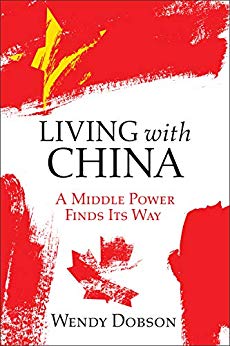
Review of Living with China: A Middle Power Finds Its Way, by Wendy Dobson. University of Toronto Press, 2019.
China’s former premier once criticized his country’s economy as “unstable, unbalanced, uncoordinated, and unsustainable.” Regrettably, it can also serve as a succinct summary of the worldview, focus, recommendations, and implications of a new book on Canada’s relationship with China.
Wendy Dobson, a Canadian academic specializing in economic analysis and policy, writes amid a trying moment in Canada-China relations. It is not enough that Canada’s largest trading partner, the United States, is engaged in a broad-ranging economic conflict, with its second largest partner, China. Since December 2018, when Canada honored a US request and arrested Huawei CFO Meng Wanzhou, China has responded with fierce political and economic retaliation. Coinciding with revelations about China’s efforts to influence and interfere with Canadian institutions and society, there has been a marked drop in favorable Canadian attitudes about Beijing.
But even before the deterioration in ties, recognition was emerging in Canada, as it has in other Western middle powers such as Australia and New Zealand, that the country needed to reevaluate its relationship with China as it appeared to no longer be on the path of liberalization.
For a book that declares boldly in its opening pages that Canada “lacks a China strategy,” it subsequently fails to deliver. Instead, all but the final chapter of this slim volume is devoted to Chinese politics in the Xi era, its economy, and growing international ambitions. None of this analysis surpasses other treatments on the topics nor offers a Canadian lens with which to appreciate their implications.
Despite acknowledging all that has changed in the relationship, and perhaps most critically within China itself under Xi Jinping, Dobson nonetheless maintains the usual sloganeering of a strategy based on “mutual respect, accommodation, and genuine discussion of differences in values and institutions.” But what if, as all evidence suggests, China is unwilling to engage on any of those terms?
Unsurprising not because of Dobson’s background, but the book’s nominally broader ambitions, is the emphasis on trade. Specifically, now that a comprehensive free trade agreement Canada had pursued is no longer viable, she advocates for narrower sectoral agreements. But Dobson never satisfyingly explains why the appropriate response to a country to which Canada is already at risk of economic coercion is to increase opportunities for that coercion even more. In another instance, that she takes an agreement to not commit state-directed cyberattacks for something other than what it is – empty – is a stunning display of naivete given that Australia’s parliament and main political parties were subject to such an attack in May.
These failures only underscore Dobson’s motivation that middle powers need new China strategies that also take into account a relatively less powerful and, regrettably, less dependable, United States. Yet, declarations that “Canada will need to continue to find a way to live with China by carrying through its commitment to promote trade, investment, security, and other common interests, seeking to engage Communist Party officials and civil society in the pursuit of global and long-term interests, while standing up for its values” is a near exact inversion of what should be any nation’s priorities.
The rush to return to the status quo ante is one that other Canadians are rightfully reconsidering. David Mulroney, a former Canadian ambassador to China, has written that “given the undeniable evidence of China’s hostility to core Canadian interests, starting with the safety of our citizens, we urgently need to reconsider our approach.” He challenges the guiding “fictions” of Canada’s approach to China that is premised on the notion of a China that, among other things, is inherently peaceful, does not interfere in other countries’ affairs, and bestows trade as a favor on friendly nations.
Instead of prioritizing bilateral engagement, middle powers such as Canada, the United Kingdom, Australia, and New Zealand, ought to refocus their attention on strengthening their alliances and consider a joint approach to China. Together, they are the world’s fourth largest economy after the US, EU, and China and rank similarly in terms of defense spending. Their collective strength and values would make it harder for China to continue its coercive course.
Unfortunately, it is difficult to read in the appointment as the next Canadian ambassador to China of Dominic Barton, former managing director of the consultancy McKinsey & Company, with which this reviewer has also been affiliated, anything other than an attempt to return to doing business, whatever the costs to Canada’s values and autonomy. This book will be an all too useful guide on that mistaken mission.